If you’re looking for a way to boost your PS4 gaming experience, a wifi extender might just be what you need. A wifi extender for PS4 can improve your internet connection, reduce lag, and enhance your online gameplay.
Before you purchase a wifi extender, it's important to consider a few factors. Firstly, you'll need to check the compatibility of the extender with your PS4. Secondly, take into account the range and signal strength of the wifi extender. Lastly, consider the brand reputation and customer reviews, to ensure that you are making an informed and wise decision.
Are you tired of your online gaming experience being disrupted by poor internet connections and frequent lag? Do you want to enhance your skills and take your gaming to the next level? If so, keep reading to learn more about how a wifi extender for PS4 can improve your gaming experience. Which factors should you consider when choosing a wifi extender? And what are some of the best options currently available on the market? Find out here.
10 Best Wifi Extender For Ps4
| # | Product Image | Product Name | Product Notes | Check Price |
|---|---|---|---|---|
|
1
|
This product is ideal for extending the range of Bluetooth and WiFi signals on Mini PCIe cards.
|
|
||
|
2
|
The product is ideal for extending the range and speed of Wi-Fi networks with its dual-band technology, gigabit port, and MU-MIMO.
|
|
||
|
3
|
This product is ideal for extending and boosting WiFi signals with strong penetrability, full coverage, and support for multiple devices.
|
|
||
|
4
|
This product is ideal for wirelessly streaming video and audio from multiple devices to a television or projector.
|
|
||
|
5
|
The product is ideal for extending WiFi coverage and improving signal strength for multiple devices in a large area.
|
|
||
|
6
|
Ideal for extending WiFi internet signal range and strength at home or outdoors, capable of supporting multiple devices.
|
|
||
|
7
|
The product is ideal for providing fast, reliable Wi-Fi coverage to large homes with multiple devices.
|
|
||
|
8
|
This product is ideal for extending and strengthening wireless internet signals in larger homes or buildings with multiple devices.
|
|
||
|
9
|
This product is ideal for improving Wi-Fi signal strength and range in homes, supporting multiple devices and easy setup.
|
|
||
|
10
|
It is ideal for extending the range of WiFi signals and improving internet connectivity at home with Ethernet port access.
|
|
1. Extended Range Kit For Ps4 Antenna Upgrade
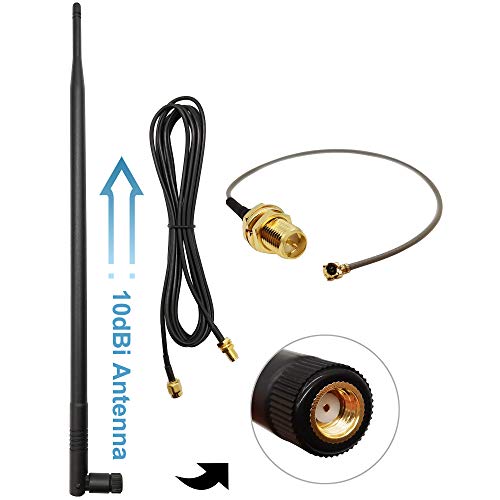
The PS4 Antenna Kit is a specially designed device that helps extend the signal range of PS4 Bluetooth. It operates on a frequency range of 2400-2500 MHz(2.4Ghz) and has a high gain omni antenna of 10dBi. The antenna comes with an RP-SMA male connector that has a hole inside and is 15.35in/39cm in length. The kit also includes an internal bluetooth cable with a U.FL to RP-SMA female (pin-inside) connector cable that is 10in/25cm long. Moreover, it has an external extension cable that is RP-SMA male (hole-inside) to RP-SMA female (pin-inside) cable that is 10ft/3m in length.
If you're looking to improve the range of your PS4 Bluetooth, the PS4 Antenna Kit is an excellent choice. It is specially designed for PS4 devices and can help extend the signal range. Please note that the kit may not work as effectively on other Bluetooth devices.
This kit features a high-gain omni antenna with a gain of 10dBi, making it perfect for PS4 devices. The RP-SMA male connector with a hole inside makes it easy to install and provides a secure connection. The antenna is also 15.35in/39cm in length, making it easy to position for optimal signal reception.
The PS4 Antenna Kit comes with an internal bluetooth cable with a U.FL to RP-SMA female (pin-inside) connector cable that is 10in/25cm long. This cable ensures that the signal is transmitted efficiently and without any loss. The external extension cable is RP-SMA male (hole-inside) to RP-SMA female (pin-inside) cable that is 10ft/3m in length, providing ample length to position the antenna for optimal signal reception.
- Specially designed for PS4 devices to extend signal range
- High gain omni antenna of 10dBi
- RP-SMA male connector with a hole inside for easy installation and secure connection
- Internal bluetooth cable with a U.FL to RP-SMA female (pin-inside) connector cable that is 10in/25cm long to ensure efficient signal transmission
- External extension cable is RP-SMA male (hole-inside) to RP-SMA female (pin-inside) cable that is 10ft/3m in length, providing ample length to position the antenna for optimal signal reception
- – May not work as effectively on other Bluetooth devices
2. Turboboost Wifi Range Extender – Ac2600
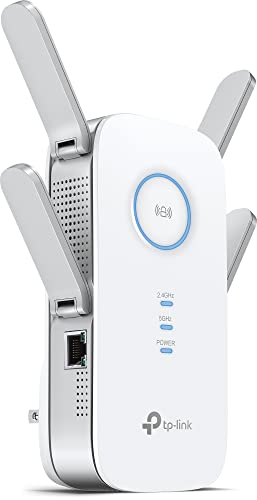
The TP-Link RE650 Wi-Fi extender is an easy-to-install device that can extend the range of your Wi-Fi signal, making it ideal for homes or offices. This dual-band extender is compatible with any type of router, gateway or access point, and can provide a maximum speed of 800Mbps at 2.4GHz and 1733Mbps at 5GHz, giving you faster and more reliable internet connections.
With its quad-antenna design, the RE650 can provide ultimate coverage for all areas of your home or office, ensuring that you get the best possible signal strength wherever you are. The MU-MIMO Wave 2 technology allows the RE650 to talk to multiple devices at once, making it ideal for busy households or offices with multiple users.
The TP-Link RE650 also features beamforming technology, which sends targeted Wi-Fi signals to individual devices for stronger connections. This technology ensures that you get the best possible signal strength and the fastest possible speeds, making it ideal for applications such as retail POS, internet, gaming, mobile phones, Alexa, Echo, and more.
The RE650 also features smart indicator lights that help provide optimal placement for the best signal strength. This extender should be installed between the router and the desired area, and the gigabit Ethernet port connects wired devices to your network for high-speed connections.
Overall, the TP-Link RE650 Wi-Fi extender is a great investment for anyone looking to extend the range of their Wi-Fi signal. With its easy installation process, stable connections, and 2-year warranty, this device is a must-have for anyone looking to improve their internet experience.
- Easy to install
- Stable connections
- MU-MIMO Wave 2 technology
- Beamforming technology
- Smart indicator lights
- Gigabit Ethernet port
- 2-year warranty
- – May not directly increase speed
- – Improving signal reliability can affect overall throughput
3. Maxboost Wifi Extender: Strong Signal, Massive Coverage
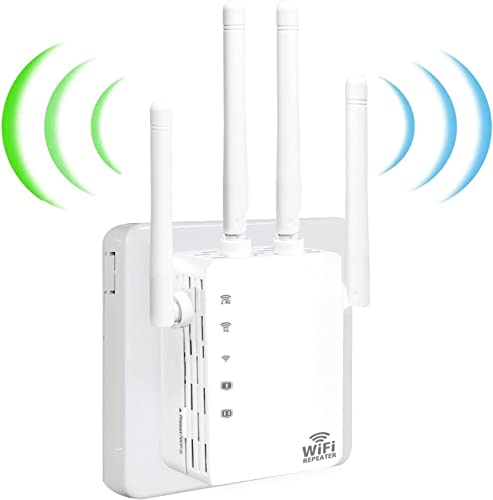
Upgrade your home or office wireless network with this high-speed and stable signal Wifi Extender. With the latest dual-band technology, it can provide up to 300Mbps for 2.4GHz and up to 867Mbps for 5GHz, giving you a total rate of 1200Mbps. This reduces data transmission loss and provides a fast internet mode, making it perfect for HD video or gaming.
With its four high-gain external antennas, this Wifi repeater can cover up to 360 degrees and up to 9000 square feet, supporting 35 devices. It eliminates dead spots in your bedroom, toilet, garden, garage, basement, and other areas, providing stable Wifi signals.
This Wifi extender has two modes, Repeater/AP, that you can switch between instantly. The Ethernet port allows you to expand your wired network to a wireless network and connect to any wired ethernet devices, such as smart TVs, PlayStation, and more.
This Wifi extender is compatible with any 802.11b/g/n/a/ac wireless internet router, meaning it works with any standard router or gateway. You can easily set it up by pressing the WPS button or via the browser website (192.168.188.1) on almost any device, including Windows/Android/iOS mobile platforms.
This Wifi extender maximizes network security, ensuring that your network is safe and protected from others trying to steal your net or accessing your important data. It also avoids interference and privacy problems of Wi-Fi, providing you with a safe and secure network. You can enjoy a worry-free shopping experience with our team offering a 180-day return or replacement quality warranty and 24/7 lifetime technical support.
- High-speed and stable signal with dual-band technology
- Full signal coverage up to 9000 sq.ft and 35 devices
- Two modes, Repeater/AP, and an Ethernet port for easy setup
- Universal compatibility with any 802.11b/g/n/a/ac wireless internet router
- Maximizes network security and avoids interference and privacy problems
4. Wireless Hdmi Extender For Ultimate Streaming.
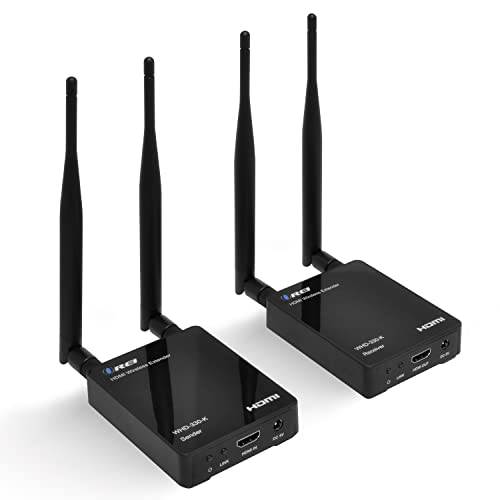
Experience high-quality, wireless video transmission with the OREI Wireless HDMI Extender, which can extend full 1080P signals up to 330 feet. This device is perfect for adding an extra TV around your home without the need for additional cables or installation. With only 0.3-1 second of delay-latency time, this device is ideal for personal home use, but not recommended for real-time shooting or PC operation.
The wireless frequency band of 5G ensures that there is near to no interference, providing a stable and reliable transmission of your video signals. The device supports point-to-point wireless connection and a wide range of HDMI resolutions, including 480i 60HZ, 480p 60HZ, 576i 60HZ, 576 50HZ, 720p 50/60HZ, 1080i 50/60HZ, and 1080P 50/60HZ. With plug-and-play setup, there is no need for any complicated software installation.
In addition, the OREI Wireless HDMI Extender features full band IR return of 30 ~ 60 Khz, which allows for seamless remote control operation. The package includes one transmitter, one receiver, two power adapters, one IR emitter, one IR receiver, and a user manual. The OREI Manufacturer's Warranty covers the product for one year, and extra receivers can be purchased separately.
- Wirelessly extend full 1080P signals up to 330 feet
- 5G wireless frequency band with near to no interference
- Point-to-point wireless connection
- Supports a wide range of HDMI resolutions
- Plug-and-play setup without any software installation
- Full band IR return allows for seamless remote control operation
- Includes one year OREI Manufacturer's Warranty
- – Not recommended for real-time shooting or PC operation
- – May not work if there is a Wi-Fi router nearby
5. Onemesh Wifi Booster By Tp-Link.
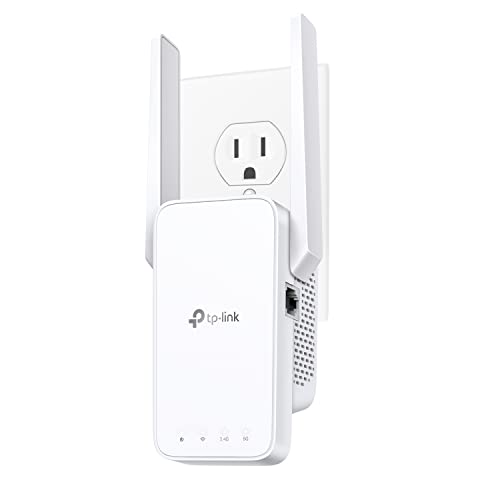
The TP-Link RE315 Wi-Fi Range Extender is a highly efficient device that allows you to extend your Wi-Fi coverage up to 1500 square feet. With its ability to connect up to 25 devices, this range extender is a great choice for large households or small offices. It is compatible with any Wi-Fi router or access point, making it an easy and convenient solution to extend your Wi-Fi coverage.
The RE315 range extender also features a fast Ethernet port that provides reliable wired speed and performance to any device that requires it. This feature makes it easy to connect your favorite devices to the Ethernet port and enjoy fast and reliable internet speeds from anywhere in your home. Additionally, the Ethernet port can also be used to turn your wired internet connection into a wireless access point, which is great for connecting wired devices like Blu-ray players, game consoles, or smart TVs.
This range extender is universally compatible with all Wi-Fi-enabled devices and routers, making it easy to set up and use with any device. It also supports TP-Link OneMesh, which allows you to create a mesh network by connecting to a OneMesh router like the Archer A7 or Archer AX21. This feature provides seamless whole-home coverage, ensuring that you can stay connected no matter where you are in your home.
Overall, the TP-Link RE315 Wi-Fi Range Extender is a reliable and efficient solution to extend your Wi-Fi coverage. Its universal compatibility, access point mode, and fast Ethernet port make it an excellent choice for anyone looking to improve their internet connectivity at home or in the office.
- Extends Wi-Fi coverage up to 1500 square feet
- Connects up to 25 devices
- Fast Ethernet port for reliable wired speed and performance
- Can be used as a wireless access point
- Universal compatibility with all Wi-Fi-enabled devices and routers
- Supports TP-Link OneMesh for seamless whole-home coverage
6. Ultimate Wifi Boost For Large Homes: 2023 Extender
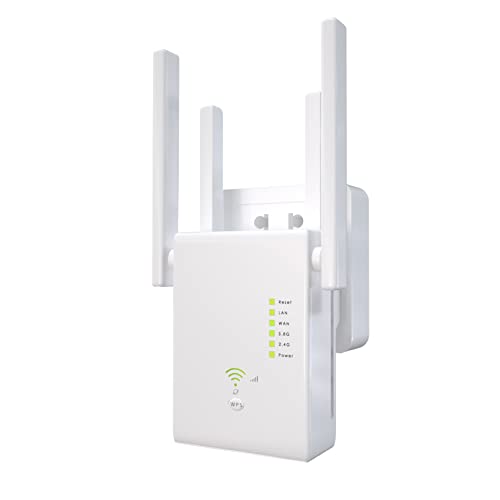
The WIFI SIGNAL BOOSTER WITH HIGH SPEED 1200Mbps is the perfect solution for those who are experiencing slow internet speeds and dead zones in their home. This latest Wifi booster comes with 4x3DBI OMNI Directional Antennas that support dual band 2.4G/5.8G, providing a total rate of about 1200Mbps. With this booster, you can enjoy HD video/games and fast internet speeds without any interruptions.
This OUTDOOR WIFI EXTENDER LONG RANGE SIGNAL COVERAGE can extend the signal up to 6000 Sq.ft straight line distance, making it perfect for larger homes and outdoor spaces. You can now enjoy the fun of the internet with your family and friends in the garden or backyard. It is super easy to set up and will give peace to your home, reducing arguments and ensuring that everyone can enjoy the internet together without any problems.
This 3 in 1 FUNCTIONS WIFI EXTENDER BOOSTER is a Wireless Wifi Extender that has Wifi Repeater/ Wifi Router/ Wireless Access Point (WISP Mode / AP Mode / Router Mode). This Wifi range extender booster maximizes network security, ensuring your network safety and preventing others from stealing your net. It protects your important data and avoids the interference and privacy problems of Wifi, making your work and life more secure and comfortable.
This UNIVERSAL COMPATIBILITY AND ONE CLICK TO SET UP Wifi booster and signal amplifier is compatible with any standard wifi router and all wifi-enabled devices such as PC, Laptop, TV box, smartphone, pad, smart TV, and can hold up to 35 devices. It can easily extend wireless coverage by pressing the WPS button in just 8 seconds.
This PORTABLE SIZE INTERNET REPEATER is 2.7 inches x 1.6 inches x 7.9 inches (LxWxH) in size, making it convenient for your business trip or company. Its small size allows it to be fully integrated into your home without worrying about the network repeater affecting your home style. Choose this wifi extender for home and enjoy faster internet speeds and wider coverage.
- The latest Wifi booster comes with 4x3DBI OMNI Directional Antennas that support dual band 2.4G/5.8G, providing a total rate of about 1200Mbps, making it perfect for streaming HD video/games and fast internet speeds without any interruptions.
- This outdoor wifi extender has long-range signal coverage that can extend the signal up to 6000 Sq.ft straight line distance, making it perfect for larger homes and outdoor spaces.
- The 3 in 1 FUNCTIONS WIFI EXTENDER BOOSTER is a Wireless Wifi Extender that has Wifi Repeater/ Wifi Router/ Wireless Access Point (WISP Mode / AP Mode / Router Mode) that maximizes network security, ensuring your network safety and preventing others from stealing your net.
- This UNIVERSAL COMPATIBILITY AND ONE CLICK TO SET UP Wifi booster and signal amplifier is compatible with any standard wifi router and all wifi-enabled devices such as PC, Laptop, TV box, smartphone, pad, smart TV, and can hold up to 35 devices.
- This PORTABLE SIZE INTERNET REPEATER is small in size, making it convenient for your business trip or company. Its small size allows it to be fully integrated into your home without worrying about the network repeater affecting your home style.
- – None found.
7. Nighthawk Mesh Wifi System With Extended Range.
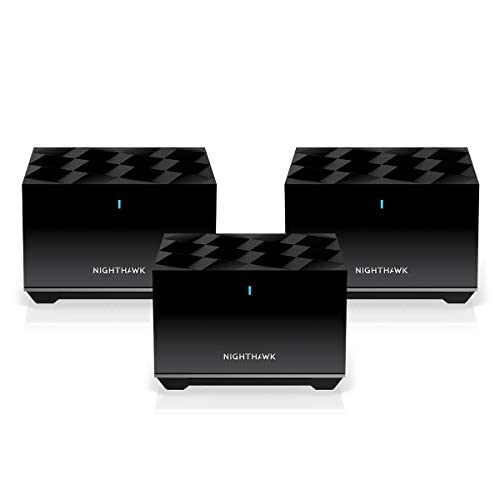
The NETGEAR Nighthawk Whole Home Mesh WiFi 6 System is designed to provide seamless coverage up to 6,750 sq. ft. and support for 40+ devices. With its advanced WiFi 6 technology and fast AX3600 Gigabit speed, it ensures uninterrupted streaming, HD video gaming, and web conferencing.
This system can be easily connected to your existing cable modem and replace your WiFi router. It is compatible with any internet service provider up to 1Gbps, including cable, satellite, fiber, and DSL. This makes it a versatile solution for all your internet connectivity needs.
Moreover, the system comes with 7 (3+2+2) Gigabit Ethernet LAN ports in the router and satellites, allowing you to plug in computers, game consoles, streaming players, and more. This ensures that you can easily connect all your devices to the network without any hassle.
Setting up the NETGEAR Nighthawk Whole Home Mesh WiFi 6 System is a breeze. You can do it in minutes with the Nighthawk App, which also allows you to easily manage WiFi settings, test internet speed, and monitor data usage. Overall, this is a robust and reliable solution for all your home networking needs.
- Seamless coverage up to 6,750 sq. ft. and support for 40+ devices
- Fast AX3600 Gigabit speed with WiFi 6 technology for uninterrupted streaming, HD video gaming, and web conferencing
- Compatible with any internet service provider up to 1Gbps including cable, satellite, fiber, and DSL
- 7 (3+2+2) Gigabit Ethernet LAN ports in the router and satellites for easy connectivity
- Easy setup with the Nighthawk App and ability to manage WiFi settings, test internet speed, and monitor data usage
8. Superboost Wifi: Ultimate Home Internet Amplifier
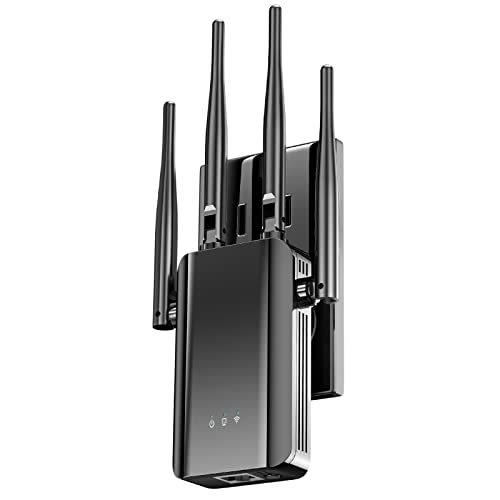
Eliminate buffering and dead zones with this WiFi extender that can cover up to 8180 sq.ft. Equipped with advanced processing unit and smart chips, it can penetrate walls without losing signals, ensuring that your WiFi network is always enhanced. The dual-core CPU provides super high speeds of up to 300Mbps and reduces data transmission loss. With this device, you can extend your WiFi network to every corner of your home.
Setting up this WiFi extender is easy and hassle-free. With just a tap on the WPS button, you can get it started in working mode within 8 seconds. This ensures that every corner of your home has a stable and secure WiFi signal. Use this device for online gaming, video conferences, and even play 4K high-definition videos anytime and anywhere in your home.
This WiFi extender supports up to 41 devices, including mobile phones, tablets, laptops, Smart TVs, security cameras, printers, and other devices. It also features Ethernet ports that realize zero-lag and allow you to connect wired devices as a wireless adapter. With its compatibility and versatility, this device is perfect for streaming and online gaming.
This WiFi extender comes with upgraded security features that protect your personal and banking data. It complies with IEEE 802.11 B/G/N standards and supports Wireless Security WPA/WPA2 protocols. Its high-end security encryption protocol ensures that your personal data is always secure. The device creates a strong security and defense wall for business and personal protection.
The WiFi extender also features five working modes, including Repeater/AP/Bridge/Client/Router modes, making it easy to meet different demands. Its Ethernet ports achieve the best performance and can connect to any wired Ethernet device. With lifelong technical support and a 24-month warranty policy, this device is an excellent investment for anyone looking to enhance their WiFi network.
- Covers up to 8180 sq.ft
- Easy to set up
- Supports up to 41 devices
- Upgraded security features
- Five working modes
- Ethernet ports achieve the best performance
- Lifelong technical support
- 24-month warranty policy
9. Max Coverage Wifi Repeater: Boost Your Signal Now!
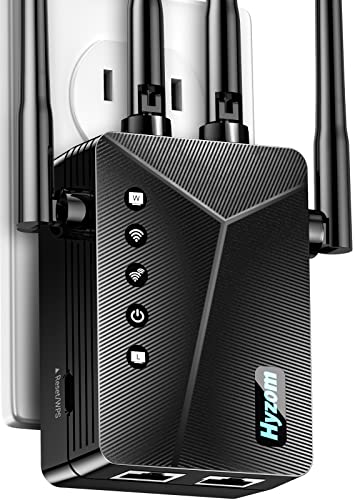
Experience smooth internet connectivity across your home and even outdoors with the Hyzom WiFi repeater. Unlike other WiFi extenders that get stuck behind walls and cement floors, this device penetrates barriers, extending your wireless internet to every corner of your house up to 9882 sq. ft., leaving no blind spots. The device is perfect for streaming 4K videos, online gaming, video conferencing, and remote learning.
The Hyzom WiFi repeater is equipped with an advanced 2.4GHz Bionic Chip that boosts your internet speed up to 300 Mbps even on long ranges. Its 4 external high-gain antennas provide a more stable signal and greater penetration, ensuring superior performance and eliminating frustrating WiFi dead zones.
The device is incredibly easy to set up and requires no technical expertise. With its one-tap setup feature, you no longer need to wait for hours for the device to activate. Simply press the WPS button of the router and repeater, and the device will be ready to use in seconds. It is compatible with any router brand and can support up to 40 devices, including smartphones, laptops, Xbox/PS, garage doors, IoT and Alexa, IP cameras, Fire Stick TV, and any WiFi supporting device.
The Hyzom WiFi repeater comes with advanced cybersecurity and privacy features. It supports WPA/WPA2-PSK security protocols, making your WiFi more secure and preventing internet attacks or private information leakage. Regular updates add more security and privacy features, making your personal data indestructible.
- Extends WiFi coverage to up to 9882 sq. ft., leaving no blind spots
- Equipped with an advanced 2.4GHz Bionic Chip that boosts internet speed up to 300 Mbps
- 4 external high-gain antennas provide a more stable signal and greater penetration, ensuring superior performance
- Incredibly easy to set up with its one-tap setup feature requiring no technical expertise
- Compatible with any router brand and can support up to 40 devices
- Comes with advanced cybersecurity and privacy features
10. Wifi Boost Pro: Power Up Your Internet!
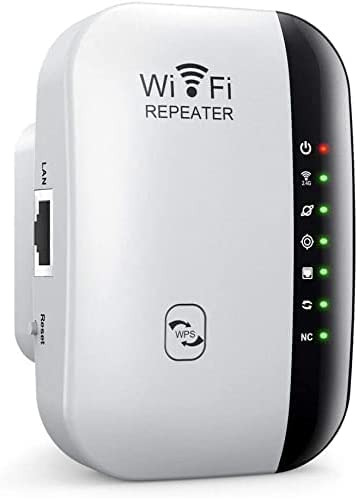
The WiFi Extender is a powerful device that can boost your internet Wi-Fi coverage up to 2640 square feet, allowing you to connect up to 20 devices. It is compatible with Wi-Fi routers, gateways, and access points, making it easy to use in any home. With brand-new software technology, the WiFi extender is simple to set up and easy to use. You can easily find the optimal location for the best WiFi connection with an intelligent signal indicator.
Say goodbye to dead zones in rooms with weak Wi-Fi coverage with our WiFi range extender. This device improves network strength and eliminates the problem of weak or broken signals. Not only is it a WiFi repeater but it also has an Ethernet port that can easily turn your wired internet connection into a new Wi-Fi access point for your home.
The WiFi Extender also keeps your network safe with its support for WPA/WPA2 wireless security protocols and regular security updates. This maximizes network security and ensures your network safety. You no longer need to worry about internet attacks or leakage of private information when using the internet. Additionally, the WiFi Extender comes with a 24-hour technical service and 24-month warranty for added peace of mind.
- Boosts Wi-Fi coverage up to 2640 square feet and connects up to 20 devices
- Compatible with Wi-Fi routers, gateways, and access points
- Easy to set up and use with brand-new software technology and intelligent signal indicator
- Eliminates dead spots in rooms with weak Wi-Fi coverage
- Improves network strength
- Can turn wired internet connection into a new Wi-Fi access point
- Supports WPA/WPA2 wireless security protocols and regular security updates
- Comes with 24-hour technical service and 24-month warranty
Best Wifi Extender For Ps4 FAQs
Are there any specific features to look for when choosing a wifi extender for PS4 gaming?
Yes, there are specific features to look for when choosing a wifi extender for PS4 gaming. Firstly, you need to ensure that the wifi extender is compatible with your PS4 gaming console. The extender should support dual-band frequencies, both 2.4GHz and 5GHz, as this will provide a better and faster connection. You should also consider the range of the extender. A good wifi extender should have a long-range to ensure that it covers a large area and can boost the signal in all areas of your gaming room. The extender should also be easy to set up and use, and have a user-friendly interface. It is also important to consider the speed and stability of the extender. Look for an extender that can provide high-speed internet connectivity without any interruptions or lagging. In summary, when choosing a wifi extender for PS4 gaming, you should consider compatibility, dual-band frequencies, range, ease of use, stability, and speed.
Can a wifi extender improve my PS4's connection speed and stability?
Yes, a wifi extender can potentially improve your PS4's connection speed and stability. A wifi extender is a device that amplifies and extends the range of your existing wifi signal. This means that if you are experiencing poor wifi signal strength and connectivity issues on your PS4, a wifi extender can potentially help to enhance the signal strength and improve connectivity.
However, it's important to note that the effectiveness of a wifi extender depends on various factors such as the distance between the extender and the router, the quality of the extender, and the number of obstructions between the extender and the PS4.
To ensure that you get the best performance from your wifi extender, it's recommended that you place it in a location where it can receive a strong signal from your router and where it can transmit a strong signal to your PS4. You should also ensure that the extender is of good quality and that it supports the same wifi standards and protocols as your router and PS4.
In summary, a wifi extender can potentially improve your PS4's connection speed and stability, but it's important to choose a quality extender and place it in the optimal location to ensure the best performance.
Can I use a wifi extender to connect my PS4 to the internet without running an Ethernet cable?
Yes, you can use a wifi extender to connect your PS4 to the internet without running an Ethernet cable. A wifi extender, also known as a wifi repeater or booster, works by picking up the existing wireless signal from your router and amplifying it to reach areas of your home or office where the signal is weak or nonexistent. You can place the extender near your PS4 and connect it to the wifi network using the WPS button or a web-based setup. Once the extender is connected, your PS4 should be able to access the internet wirelessly.
However, it's important to note that using a wifi extender may not provide the same level of speed and stability as a wired connection. If you're experiencing lag or slow download speeds, it may be worth investing in a long Ethernet cable or a powerline adapter to connect your PS4 directly to the router. But if running cables is not an option, a wifi extender can be a convenient and effective solution.
How do I set up a wifi extender for my PS4?
To set up a wifi extender for your PS4, you need to follow a few simple steps. First, plug in the wifi extender to a power source near your PS4. Then, connect the wifi extender to your PS4 using an Ethernet cable. Once you have established a connection, go to the wifi settings on your PS4 and select the wifi extender as your primary network.
Next, configure the settings of your wifi extender by following the instructions provided by the manufacturer. This may involve logging into the wifi extender's admin panel and changing the network name and password. Once you have completed the configuration, disconnect the Ethernet cable from your PS4 and enjoy faster and more stable wifi connectivity.
It is important to note that the placement of your wifi extender is crucial for optimal performance. Ideally, the wifi extender should be placed in a central location between your PS4 and your router. Additionally, make sure that the wifi extender is not obstructed by walls, furniture, or other objects that can interfere with the wifi signal.
What is the best wifi extender for PS4?
When it comes to finding the best wifi extender for PS4, there are a number of factors to consider. First and foremost, you want to ensure that the extender is compatible with your PS4 and can provide a strong and stable connection. Some of the top wifi extenders for PS4 include the TP-Link AC1750, the Netgear Nighthawk X4 AC2200, and the Linksys AC1200.
The TP-Link AC1750 is a popular choice due to its strong signal strength and easy setup process. It also boasts three external antennas for maximum coverage and speed. The Netgear Nighthawk X4 AC2200 is another great option, with four high-powered antennas and advanced features such as beamforming technology and MU-MIMO support.
Finally, the Linksys AC1200 is a budget-friendly option that still provides solid performance and range. It features dual-band technology and a compact design that makes it easy to install and use. Ultimately, the best wifi extender for your PS4 will depend on your specific needs and budget, so be sure to do your research and read reviews before making a purchase.

